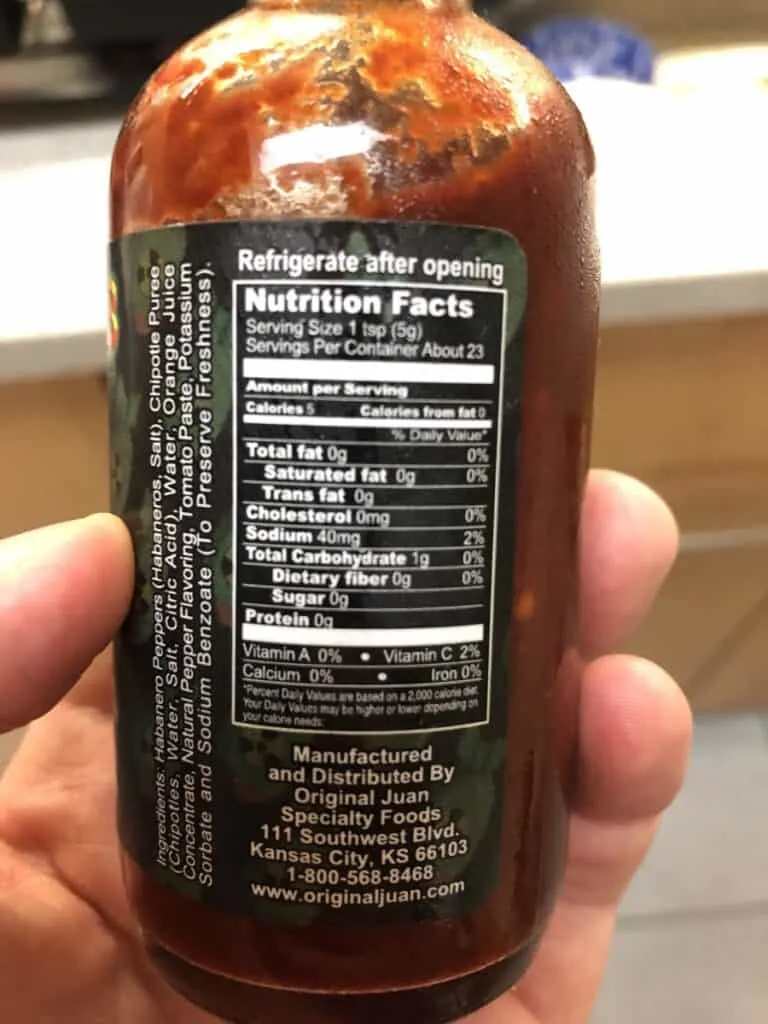Are you looking at the nutrition label on a bottle of hot sauce or a hot sauce recipe online and wondering why the calorie count for your favorite condiment is almost zero? How can something so tasty not add to the number of calories you consume throughout the day?
Hot sauce technically does have calories, but the calorie count is meager. This is because most of the ingredients used in hot sauce are very low-calorie. Additionally, hot sauce is used in small amounts as a taste enhancer, so your calorific intake is low.
In this article, we will explain why adding hot sauce won’t cause you to gain weight, even if consumed quite frequently. We will also discuss how it might even help you lose some weight if that’s something you’re striving towards.

How Many Calories are in Common Hot Sauces?
Hot sauce is super low-calorie, often showing a zero-calorie count on the bottle per serving nutritional level. We reviewed the nutritional labels of nine hot sauces and found only one of those nine had any meaningful calories per serving
| Hot Sauce | Calories per Serving | Serving Size |
| Tabasco Pepper Sauce | 0 | 1 tsp |
| Taco Bell Hot Sauce | 0 | 1 tsp |
| Crystal Hot Sauce | 0 | 1 tsp |
| Tapatio Hot Sauce | 0 | 1 tsp |
| Hoy Fong Sriracha | 0 | 1 tsp |
| Cholula Hot Sauce | 0 | 1 tsp |
| Franks Red Hot | 0 | 1 tsp |
| Heartbeat Hot Sauce | 0 | 1 tsp |
| TRUFF Original Hot Sauce | 10 | 1 tsp |
Most of the hot sauces on the list have very few ingredients, mainly water, vinegar, salt, and peppers.
The only hot sauce on the list with measurable calories per serving is TRUFF Original Hot Sauce. This hot sauce primarily gets its calories from olive oil added as an ingredient.
How Many Calories are in Hot Sauce Ingredients?
Most of the common ingredients used to make hot sauces are extremely low in calories.
Peppers
Chili peppers are relatively low in calories. They have a water content of about 88%, and plain water has no calories. The peppers themselves are about 40 calories per 100 gr (3.53 ounces).
Most calories in peppers come from the carbs and sugars in the vegetable. The nutritional values are more or less the same for all peppers. Chili peppers are high in vitamins A, C, iron, and calcium.
Garlic
Garlic is quite high in calories, but the amount used in most recipes is so small that you won’t be consuming any meaningful amount of calories.
It is high in vitamin C, calcium, and iron and has about 150 calories per 100 grams, the weight of about 33 garlic cloves.
Vinegar
Vinegar is very low in calories at just under 20 calories per 100 grams.
Vinegar has no nutritional value, and mainly consists of water (around 95%), sodium, and potassium. It’s deficient in vitamins but can completely change the flavor of foods when even a little is added.
If your hot sauce has too much vinegar flavor and you want to reduce it, check out my article – Too Much Vinegar in Hot Sauce – 6 Easy Fixes.
Salt
Unsurprisingly, salt doesn’t have any calories. Salt is a flavor enhancer and preservative. It brings out rich flavors in your dishes but can completely ruin your meal when too much is used.
If you’re planning on making your own hot sauce, pay close attention to the amount of salt you use.
Oil
Oil is NOT a low-calorie ingredient, but the amount used in a hot sauce recipe is often minimal.
You might want to add oil to your hot sauce to change its texture or to ensure the sauce nicely coats whatever food you add it to when cooking. If some oil is used in your hot sauce recipe, it will add to the number of calories you consume per serving. Oil is a high-calorie ingredient, adding up to 40 calories per teaspoon.
Oil isn’t often used in hot sauce because it doesn’t mix with water-based liquids. The oil will separate from the water, vinegar, and moisture in the vegetables if you don’t add an emulsifier, like Xanthan Gum or mustard.

Calories and Scoville Scores of Common Hot Sauces
Below is a table summarizing the calorie content, Scoville rating, and ingredients of Tabasco, Frank’s Red Hot and Cholula Original Hot Sauce.
| Tabasco | Frank’s Red Hot | Cholula Original Hot Sauce | |
| Scoville Rating | 2500 – 5000 | 450 | 500 – 1000 |
| Ingredients | Peppers, Vinegar, and Salt | Cayenne Red Peppers, Vinegar, Water, Salt, and Garlic powder | Water, Peppers, Salt, Vinegar, Garlic powder, Spices, and Xanthan gum. |
| Calories in 5fl ounces (150ml) | 25 Calories | 34 Calories | 27 Calories |
| Calories in 7fl ounces (200ml) | 34 Calories | 46 Calories | 36 Calories |
| Calories in 10fl ounces (300ml) | 51 Calories | 69 Calories | 54 Calories |
| One Serving (5ml / 1 tsp) | 0 Calories | 0 Calories | 0 Calories |
How You’re Not Consuming Any Calories From Hot Sauce
Hot sauce is a flavor enhancer, so you probably won’t be consuming it by the bottle. If one serving is about 1tsp (5mp), then most hot sauces won’t even be one calorie per serving.
It will probably mention on the hot sauce bottle that a single serving is zero calories because the calorie count per serving is less than one.
Closing Thoughts
Hot sauce labels often indicate that the calorie intake per serving is zero, simply because the ingredients usually don’t add up to a single calorie per 1tps.
The ingredients used in hot sauce, like peppers, garlic, vinegar, and salt, are low in calories. Higher calorie ingredients like oil can also be added, but they aren’t used that frequently in consumer brand hot sauces.
